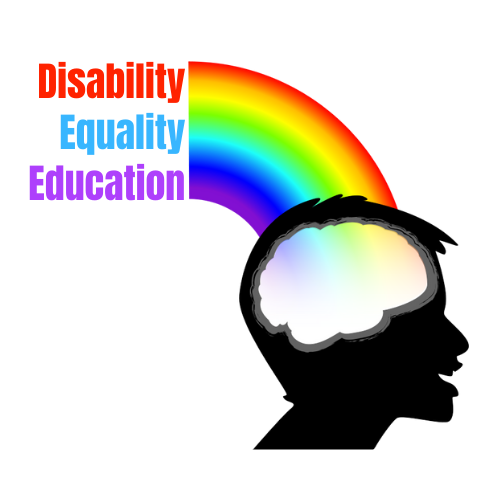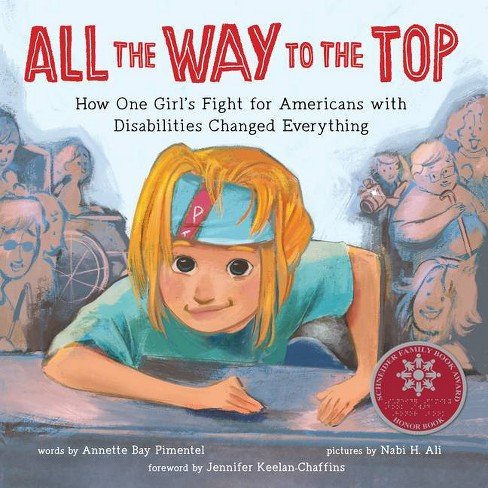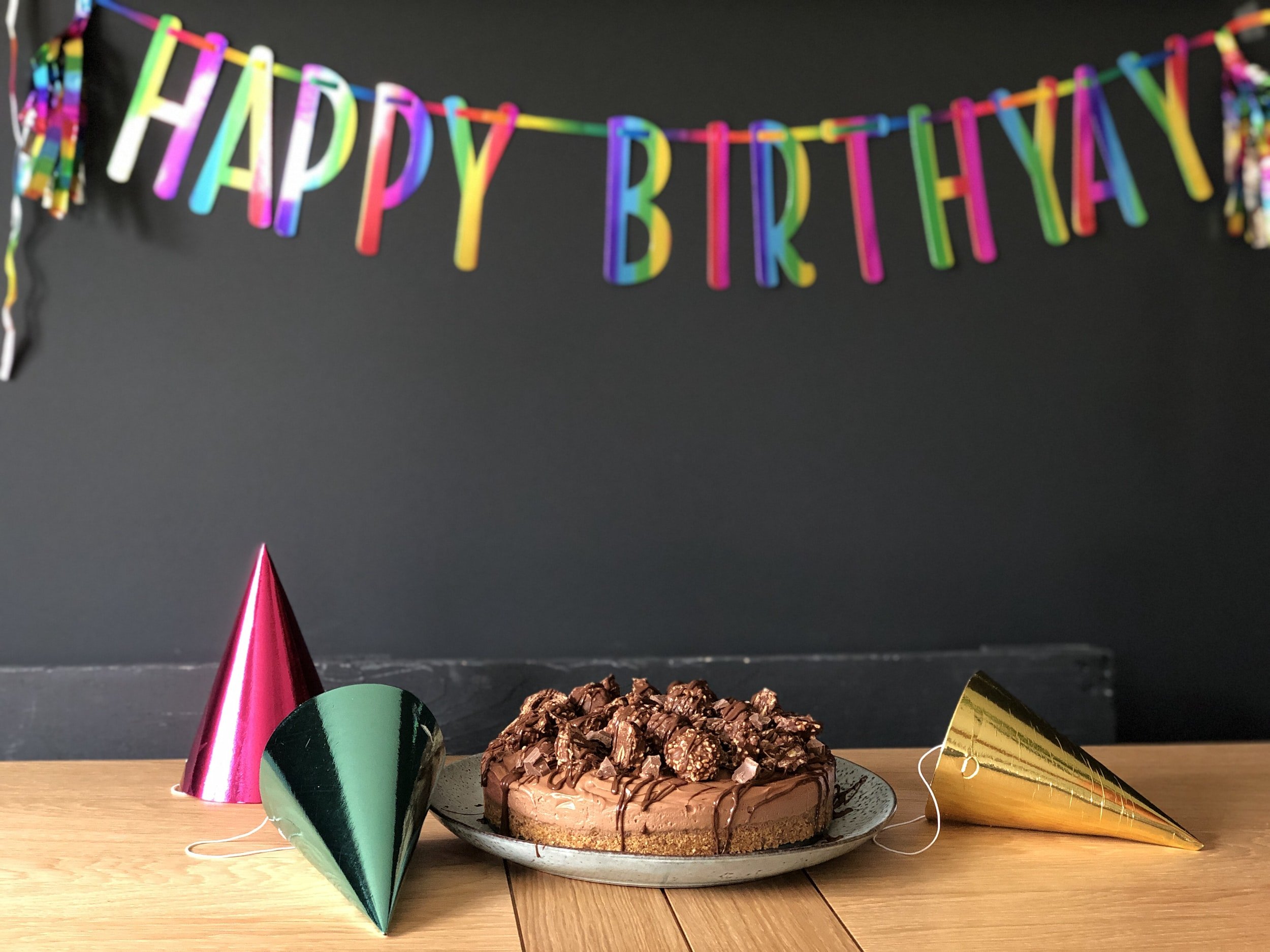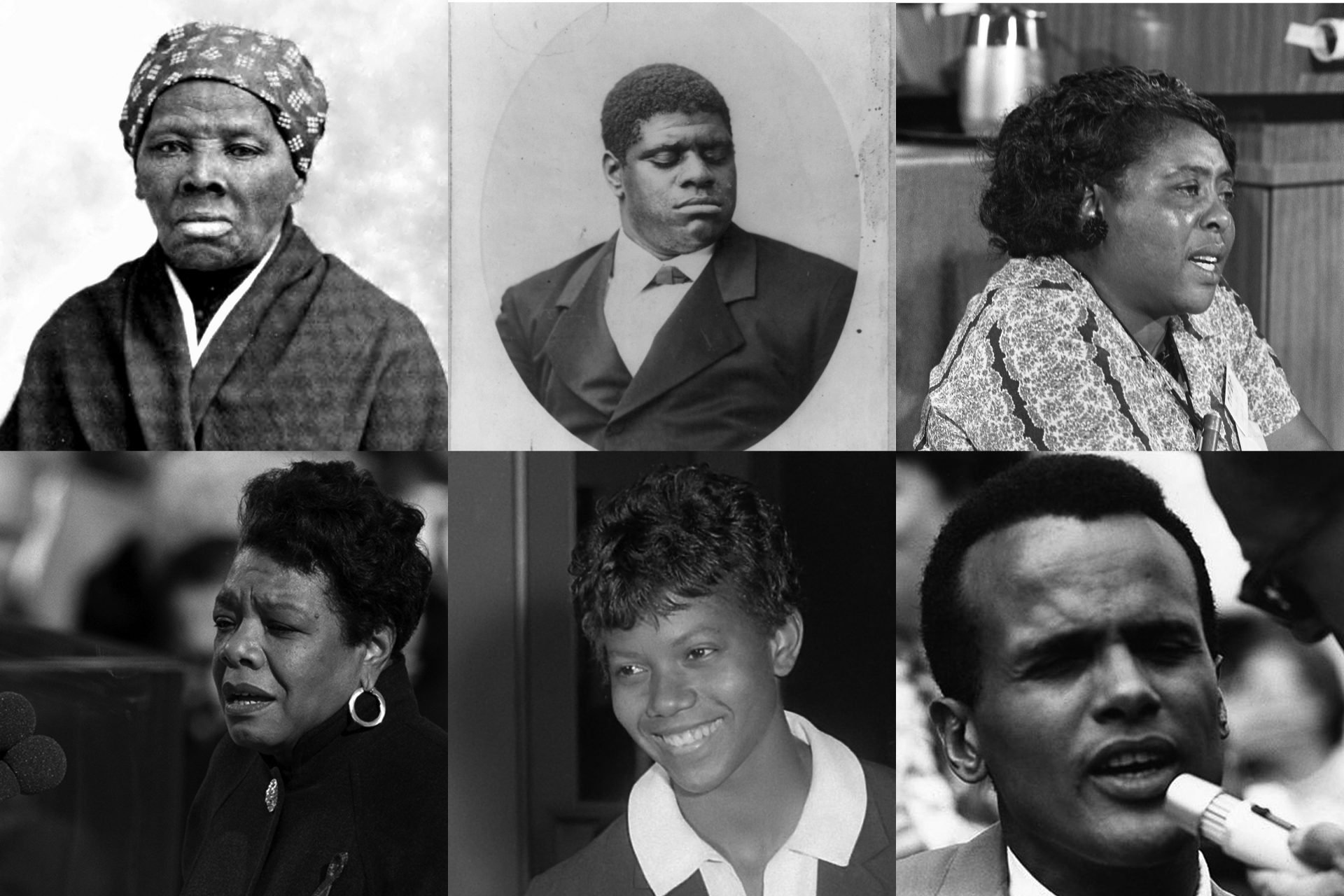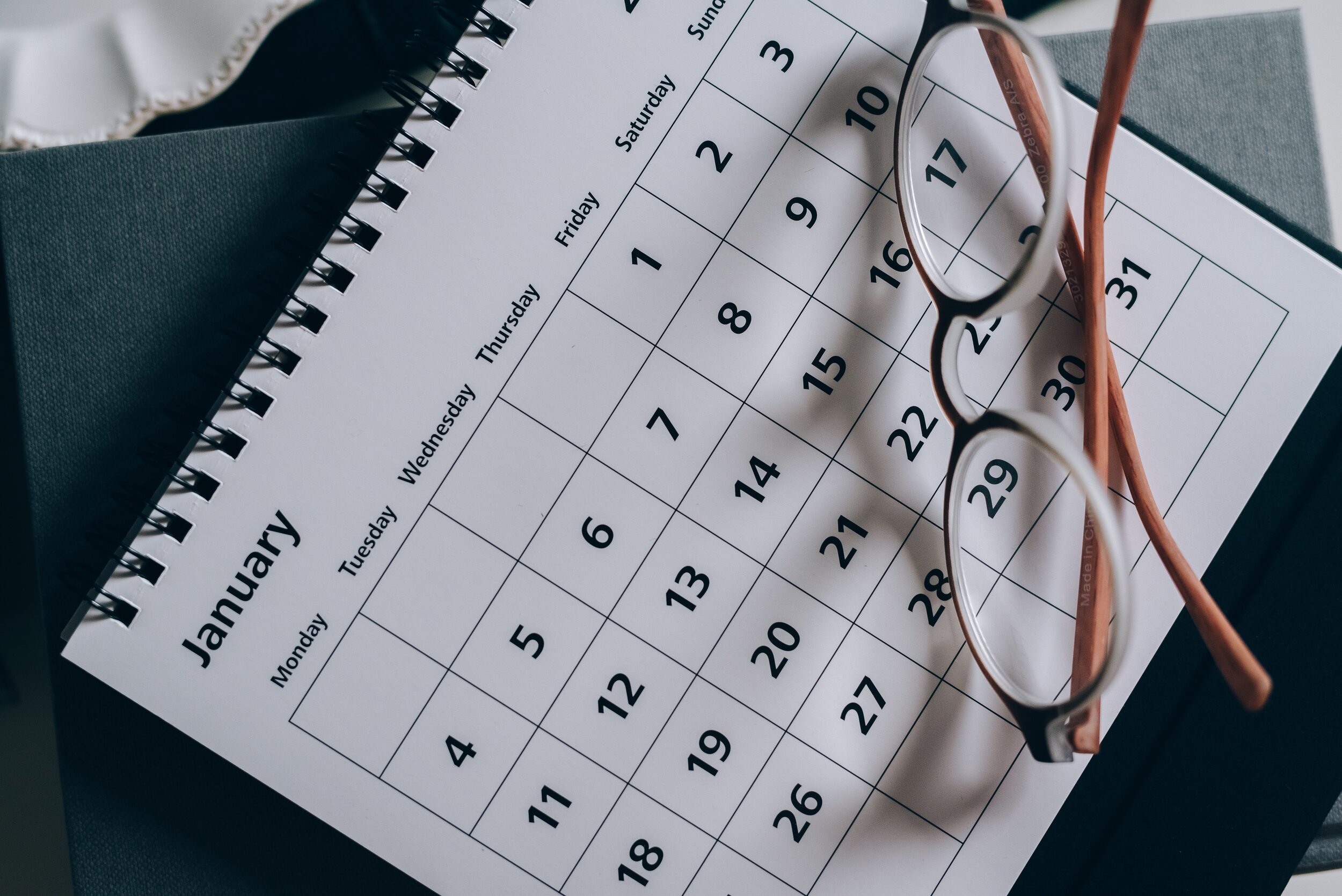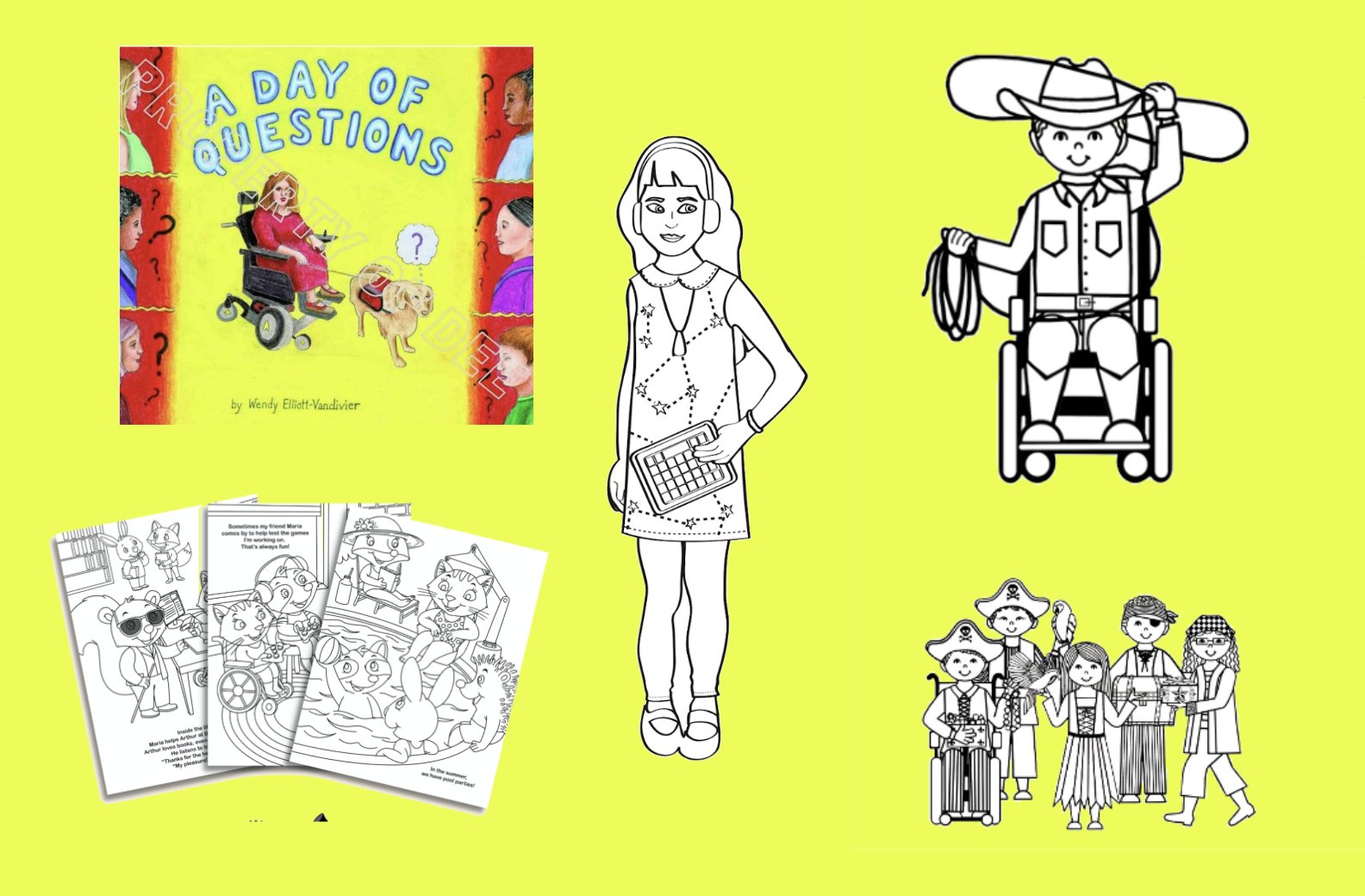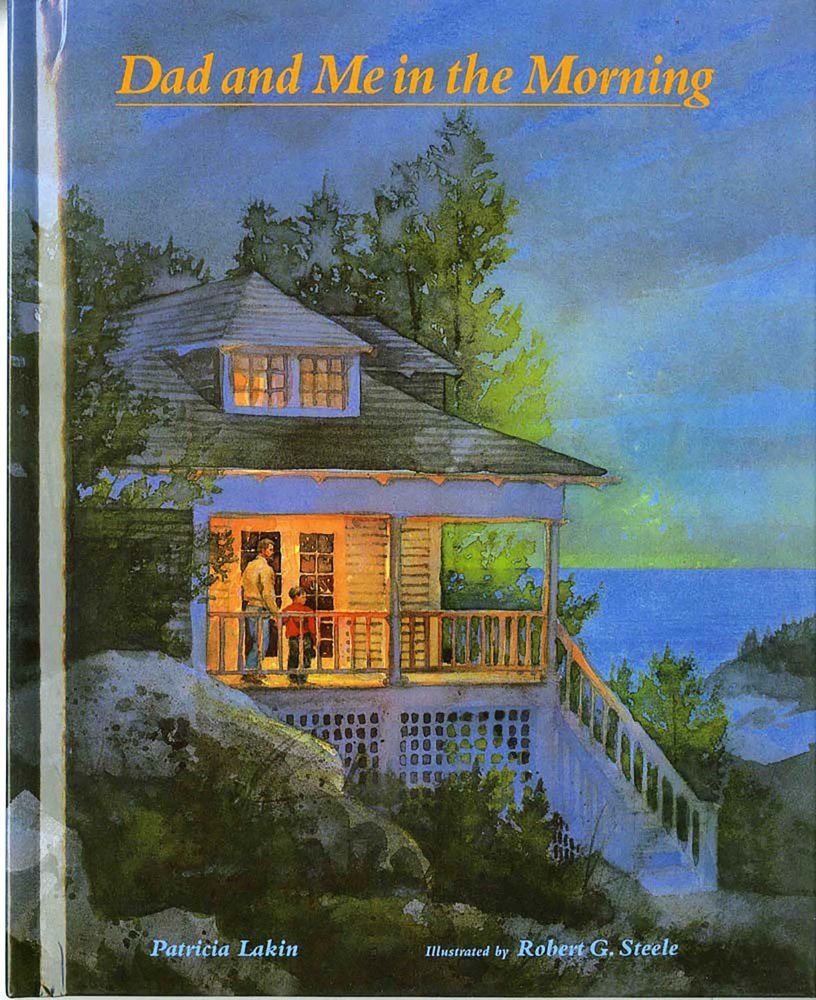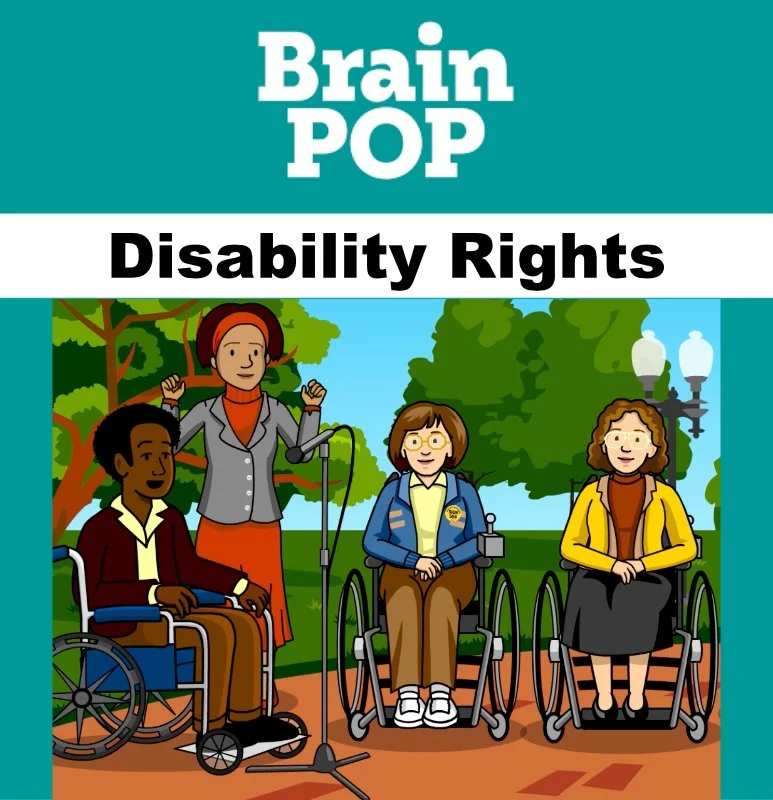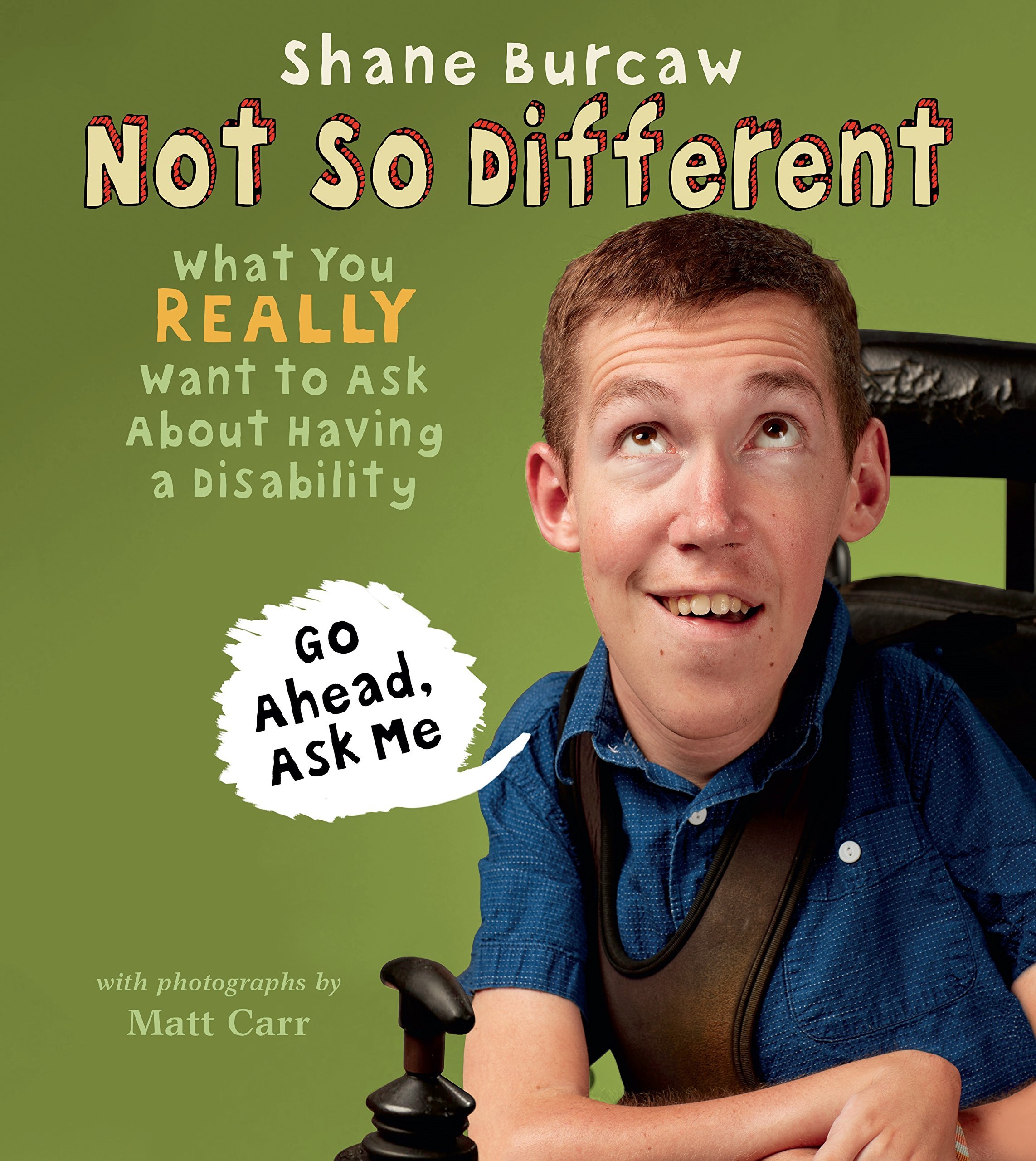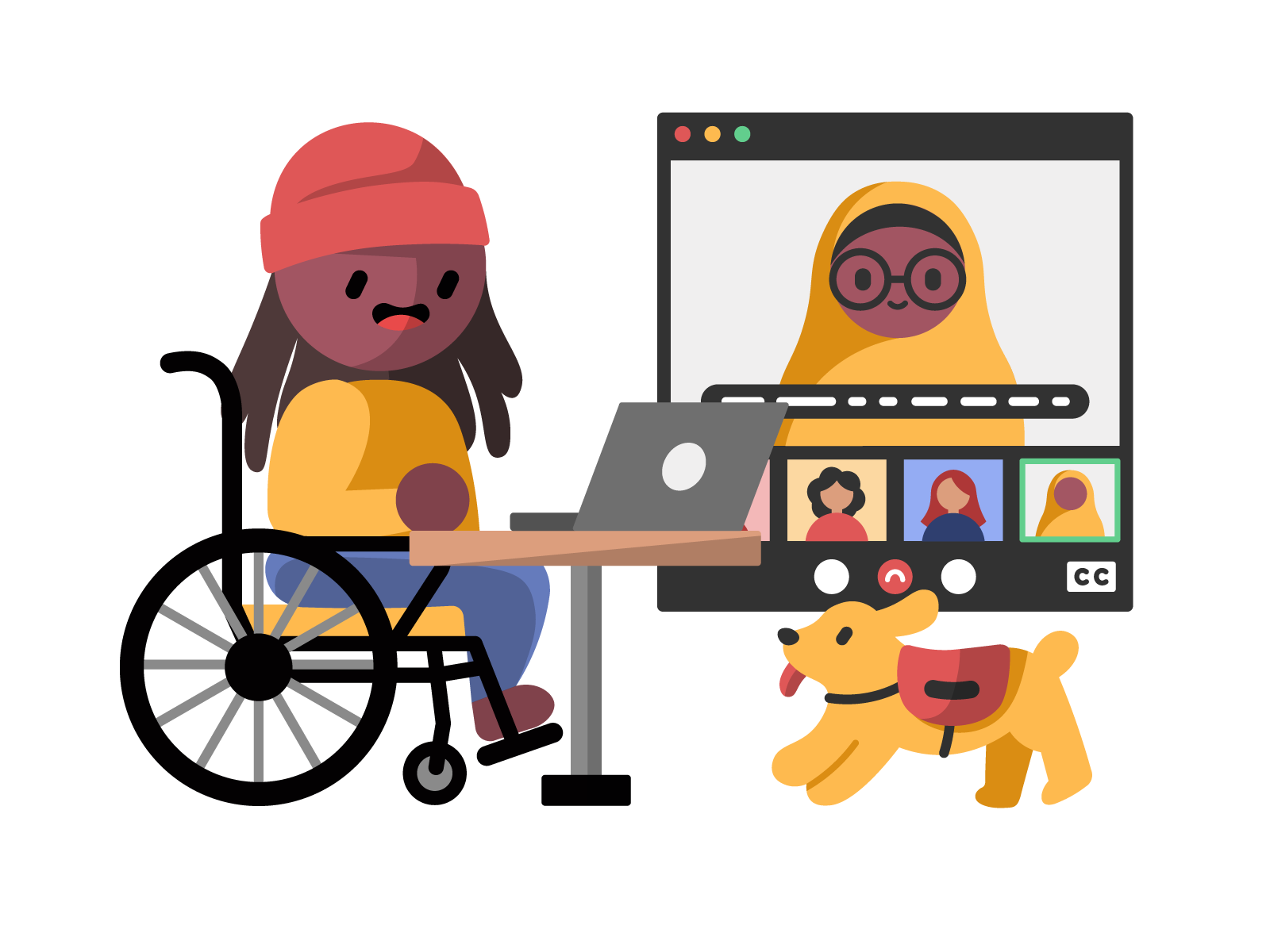
Lesson Plans for Grades 3 - 5
Start creating classroom conversations around disability.
All the lesson plans have been designed and/or approved by disabled people.
{Image description: A dark skinned wheelchair user with long hair and a beanie sits at a small table, using their laptop to participate in a video meeting. The laptop screen is shown to their right, with the call being live captioned. The main speaker is a dark skinned person wearing a hijab and glasses, and 3 other participants are at the bottom of the screen, in smaller windows. In the bottom right corner, a yellow service dog bounds towards the wheelchair user} Image “Dana Chan for Disabled And Here” from Disabled And Here.
Third, Fourth, and Fifth (3rd, 4th, 5th) Grade Lesson Plans
Click on the images or the “Read More” link to view and download PDF lesson plans.
In this lesson students will learn new vocabulary words and explore important civil rights themes by reading the book “All the Way to the Top” by Annette Bay Pimentel. “All the Way to the Top” tells the childhood story of Jennifer Keelan-Chaffins, who climbed all the way to the top of the stairs of the US capitol in 1990 to encourage congress to pass the Americans with Disabilities Act (ADA). Jennifer has cerebral palsy and became famous for the photos taken of her while climbing the stairs without a wheelchair at just 8 years old. The book tells the story from her perspective and covers how she felt she was not treated equally in her community and how she and other activist worked to get the ADA passed.
Image description: Cover artwork for “All the Way to the Top”
This lesson will help students to analyze the theme of a poem. Students will compare their understanding of how they view disability before and after reading the poem. Students will compare the message and theme of the poem and contrast the bird in the poem to the life of a person with a disability.
Image Description: Chickadee sitting in a baseball hat
This is a lesson about Astrophysicist and Computer Scientist Dr. Wanda Diaz-Merced who is a blind scientist who studies the stars by listening to data converted into sound through a process called sonification.
Sonification is the use of non-speech audio to convey information or perceptualize data. To put it more simply, Sonification is the process of using sound to convey information or turning data into sound. Sometimes, sonification can convey more detailed information better than visual representation can.
Sighted and blind people use sonification to gather information. And blind people can use sonification to study the stars and the universe.
This lesson can supplement Science units about Sound, Space, or Technology. It can even be adapted to supplement Music lessons about pitch and tone.
Image Description: The image is a digital artwork featuring a black and white photo of a Wanda Diaz Merced, who is wearing a headset with a microphone and appears to be speaking. She is set against a colorful, abstract background that includes a large orange circle, a smaller yellow circle, and a blue brushstroke. There are also various abstract shapes and patterns, including dots and lines, scattered around the image. On the left side, vertically, it says "SONIFICATION OF STARS" and on the right side, horizontally, it reads "WANDA DIAZ MERCED" in yellow text.
In this lesson, students will consider what accommodations they can make in order to be more inclusive of their peers with disabilities.
Image description: Photo of cake, birthday hats and Happy Birthday banner
In this lesson, students will be invited to research a famous Black Disabled person, either from history or modern day. Students will work in groups or individually to research their assigned person and create a final project in a creative format. Students will then present their findings to the class.
Image description: Photos of 6 famous Black Disabled people: Harriet Tubman, Tom Wiggans, Fannie Lou Hamer, Maya Angelou, Wilma Rudolph, and Harry Belafonte
On the YouTube page linked you will find a playlist with dozens of read a loud videos of books that we believe will add opportunities to incorporate disability representation in natural, positive ways to your class.
Image description: colorful books on a dark bookcase
In this lesson, students complete grade-appropriate math problems using facts and figures from Rick Hansen’s Man In Motion World Tour. Students will examine mathematical problems evolving out of the day-to-day challenges of Rick Hansen’s Man In Motion World Tour. Students will apply multiplication and division skills to real-life math problems. Students will apply conversion skills to real-life math problems.
Image Description: Logo of Rick Hansen Foundation.
A calendar of events that recognizes various days (and months) is an easy way to bring the conversation about disability into your classrooms and schools. Including discussion of disabled people throughout the year sends a message to all that disabled students are recognized and valued as a part of the education community.
Image description: calendar page tilted at an angle, reading glasses rest on the bottom corner of the calendar
Including coloring pages and artwork in lessons (some of these allow you to use as clip art) that includes disability representation furthers the goal of regularizing disability by seeing it and offering opportunities to learn and ask questions.
Image Description: small images of the coloring books on a yellow background
Students will participate in an interactive read-aloud and discussion of the picture book “Come Over to My House” by Eliza Hull and Sally Rippin, exploring its representation of disabilities. They will respond to a writing prompt inspired by the book and create artwork to accompany their writing. The lesson concludes with reflective questions and optional follow-up activities to address student inquiries.
Image Description: Cover of a children's book titled "Come Over to My House." It features a group of children and a dog and 2 adults at an open door. One child is in a wheelchair, another is upside down, and there is a dog sitting in the middle. The children are smiling and appear welcoming.
In this text, students will learn about how video games are being adapted to meet the needs of players with disabilities. Students will practice analyzing text structures. They will understand how paragraphs build on one another and how authors organize their writing using specific text structures such as subheadings.
Image Description: Logo of CommonLit, which looks like an open book at the top, with an image of a student and 3 computer screens against a blue curtain
Students will explore problem-solving by learning how scientist Joshua Miele and ballerina Krishna Washburn overcame challenges. They will then create their own invention - either practical or imaginative - through drawing, writing, or crafting a model. Afterward, they will be paired with a student interviewer who will either conduct a class interview or write a news article about their invention.
Image Description: “Creative Problem Solving with Joshua Miele and Krishna Washburn” in black text on a medium to light blue rectangle. The background of the image is a few dozen black question marks in various fonts, sizes and angles
Summary:
In this lesson, students will look at four different characterizations of autistic children in contemporary media. They will watch excerpts or videos featuring the characters, read about the characters, and study how they were created. They will then fill out an evaluation chart to analyze the different depictions. They will have a group discussion as a class and write a reflective response.
Issues considered will include: character’s role within the show/movie; who was involved in writing/creating the characters; what public response has been; and so on. The lesson will conclude with a group discussion and students will complete a journal-style piece of writing as an exit ticket.
The characters that the students will learn about are:
Julia from the television show Sesame Street;
Pablo from the television show Pablo;
the main character from a Pixar short called Loop;
Carl, from the show Carl the Collector.
Image Description: Upper left quadrant is Julia, a muppet with yellow skin and orange hair. Upper right quadrant shows the main character from Loop, a girl with brown skin and dark hair who is reaching with her hands to touch reeds. Bottom left quadrant shows Pablo, a hand-drawn boy with light skin standing on a green hill with a rainbow behind him. Bottom right quadrant shows Carl, an illustrated raccoon wearing an argyle sweater.
This lesson revolves around the book Dad and Me in the Morning by Patricia Lakin. The book tells the short story of a boy and his dad getting up early to see the sunrise. The book is unique because the boy in the story is deaf and the book shows the different ways he and his dad communicate. It is a great example of how the disabled perspective can be brought to a story that most children can relate with. In this lesson the teacher will read the book page by page and stop on each page to have students figure out all the different ways the boy and his Dad are communicating. The students will compete to see who can find the most ways.
Image description: Cover art from “Dad and Me in the Morning” book
This lesson has five activities which can be spread between multiple days as time allows within English Language Arts blocks. Through a teacher-led interactive read aloud and whole class discussion of the story: “Different: A Great Thing to Be” by Heather Avis, students will be encouraged to identify similarities between themselves and the main character in the story, Macy, and their classmates, as well as embrace differences within themselves, Macy and their classmates.
Image Description: a light purple background with 7 different colorful birds standing on a thin branch. The text above says “Each of us is different and that’s a good thing!” The word different is bigger and each letter is in vibrant different colorful patterns.
Students will identify personal similarities and differences between peers. Students will listen to read/listen to “Different… A Great Thing to Be” and identify rhyming words. After the lesson, students will write a poem about being different.
Image Description: cover of the book "Different: A Great Thing to Be!" includes an illustration of a girl with long brown hair holding flowers. Her eyes are closed and she's wearing glasses.
As our friends from Engaging America state, “Primary sources … can provide entry points and deepen exploration into historical events. Primary sources add immediacy, such as the faces in a photograph, the emotional tone of a drawing or song, or the complex look of a handwritten document. Documents from multiple points of view can illuminate conflicting ideas and events. Varied media, including maps, oral histories, published reports, and graphs offer many options for connection and investigation”.
We share these collections or primary sources as tools to continue introducing disability into the conversation from natural perspectives, using disabled people to tell their own stories whenever possible.
Image Description: Article from Dallas Times Herald, Wednesday, January 14, 1986 in section “Community Close-Up” titled “Police on sidewalk wheelchair ramps changed”
Full image description can be found at: https://adaptmuseum.net/gallery/picture.php?/451/category/16
This BrainPop video and associated resources introduce the Disability Rights movement through the fight for Section 504, the law that paved the way for the Americans with Disabilities Act.
Image Description: BrainPOP logo, “Disability Rights” and animated screenshot from the video showing 4 people outdoors, 3 are seated in wheelchairs, one is standing in front of a microphone.
In this lesson, students will be exposed to the artwork of Stephen Wiltshire. Wiltshire is from Britain and known for his large-scale detailed drawings of cityscapes. After learning about Wiltshire, who is autistic, students will have the opportunity to draw their own cityscape, inspired by Wiltshire’s art. For an extra geographic element, they can write facts about their city and create a bulletin board display. They will also consider how Wiltshire is often most widely described as a savant/genius, and how these words can create challenging stereotypes, both for the autistic community and for artists. For both, these words set up unrealistic expectations about who autistic people are/can be, and what art is/can be/how much training and practice is required to be an artist.
Image Description: Photo from behind a person wearing a dark jacket and a cap with headphones that is drawing on a large, detailed cityscape illustration. The drawing appears to be a bird's-eye view of a city with numerous buildings and streets.
Lesson Summary:
Lesson 1 is essential to introduce study of disability. Lesson 2 integrates disability into study of immigration. This lesson could also stand alone, or it could support a larger immigration unit. Lessons 3 & 4 work together but could also work separately. All three lessons can be taught in one grade or introduced over multiple grades.
Image Description: Emerging America logo above text that reads “Grades 4-5: Disability, Citizenship, and Civil Rights” above a black and white photo of George Veditz presenting Preservation of the Sign Language in American Sign Language. c. 1913
Lesson Summary: In lesson 1, students explore primary sources and their own experiences to become familiar with ideas about disability and ways that students, their community, and their school can support access for everyone. In lesson 2, students identify and agree to ways to make decision-making inclusive. Students discuss characteristics of good leaders using illustrated stories of disability advocates. In lesson 3, students explore a case study of disability advocacy to dig deeper into how civic leaders strengthen their communities.
All three lessons can be taught in one grade or introduced over multiple grades.
Image Description: Emerging America logo at top with text reading “Grades K-3: Disability and Community Leadership” above a black and white photo of Eleanor Roosevelt visiting children at Langford School. c.1930
Students will read ‘Emmanuel’s Dream’ by Laurie Ann Thompson, the true story of Emmanuel, a boy from Ghana who could only use one leg. Students will then complete a worksheet with a blank tshirt on it where they will write a word or phrase about how they are different but they are proud of that difference.
Image description: Cover image for “Emmanuel’s Dream”
Students will read Not So Different: What You Really Want to Ask About Having a Disability by Shane Burcaw and consider what it means to have a disability, what inclusion means and how to create a more accessible world.
Image description: Cover for the book “Not So Different: What You Really Want to Ask About Having a Disability”
In this lesson, students consider how people communicate when they do not speak a common language. The Chilmark Deaf Community serves as a case study to engage with the wide variety of languages spoken on the Island (presently and in the past). From 1694 to 1952, Martha’s Vineyard - and specifically the towns of Chilmark and West Tisbury - had an unusually large population of people with hereditary deafness. As a result, the residents of the Island developed a local dialect of sign language, used by hearing and deaf people alike, allowing the Deaf community full and unbiased integration into Island society at large. Scientists and researchers studying the causes of deafness took great interest in Martha’s Vineyard because of deafness’ prevalence there.
Image Description: A mural with 4 simplistic cartoon-style characters drawn in black on a light tan background using sign language, movements are shown with arrows. There is foliage at the bottom and a brick wall at the top of the photograph.
The students will learn how to use a reading journal to aid their exploration of a biography “The Spy with the Wooden Leg: The Story of Virginia Hall” which will be read as a class and individually. This reading will be slow in order to help support students’ discovering how to read, process, and reflect upon biography in the form of a chapter book and use this information to enrich their study of History. Many aspects of this lesson are flexible and can be adapted to the needs of your students.
Some themes of war may be difficult for some students, it is recommended that no new difficult content be introduced on a Friday or before a long break so that the class can have the support they need as they learn about these difficult themes.
Image Description: cover of the book “The Spy with the Wooden Leg: The Story of Virginia Hall By Nancy Polette”
In this lesson, students will learn about the paintings of Mary Duffy, a multidisciplinary artist from Ireland. Mary paints expressive landscapes, often inspired by the seashores. In this lesson, students will review her paintings, and be invited to create 2 pieces of artwork inspired by different elements of Mary Duffy’s practice. One will be done in the classroom, and a second will be done in nature, with direct observation (this may be assigned as homework, depending on the weather). Students will also be invited to reflect about issues of accessibility related to nature exploration and disabled people.
Image Description: A photo of Mary Duffy painting a canvas at the beach. She is seated, wearing a red dress, using her feet to paint the canvas in front of her on a short easel. The text “Expressive Landscapes: The Art of Mary Duffy” is at the top of the image.
In this lesson, students will learn about the art of Maud Lewis, a prolific Canadian folk artist who lived in rural Nova Scotia (Eastern Canada, near the Atlantic Ocean), and worked in the mid-20th century. She is now believed to have been born with juvenile rheumatoid arthritis, but it was not diagnosed or treated in her lifetime. Students will learn about her artwork, rooted deeply in the place where she lived, and have the opportunity to keep a sketchbook for a week, and create a painting in Maud Lewis’ style that reflects their own local world. Students will also consider the complex intersections between disability, poverty and the arts that are embedded in Maud’s life story.
Image Description: a painted clam shell that features a red birdhouse in the center, surrounded by colorful flowers and two blue birds on either side. The shell is mounted on a wooden background. The artist's name, "Maud Lewis," is visible on the shell.
In this lesson, the teacher will read I Deaf-initley Can, Rhett the Heeler, a book about a Deaf girl who adopts a Deaf dog and teaches the dog sign language. The book shows the story from Rhett’s perspective of being chosen into Karlie’s family and learning about the world through sign language.
For discussion, students will think about other methods of communication. The takeaway message for students is that people (and dogs!) can communicate in many different ways—and all of them are valid.
Image Description: Cover of the book “I Deaf-initely Can - Rhett the Heeler” shows a girl and a dog sitting side by side on the grass facing away from us, looking at one another. There is a brown mountain range and sunset in the distance.
In this lesson, students will learn about the paintings of Yayoi Kusama, an artist from Japan who is world-renowned for her immersive rooms and graphic paintings. Kusama lives in a supportive facility for people who live with psychiatric conditions, and has done so since the 1970s; the exact nature of her mental health support needs has not been disclosed to the public, but she has described experiencing hallucinations, anxiety, and pain in interviews. As part of this lesson, students will learn about different housing types for people of all abilities. Students will also be able to create either a painting or an infinity room (assignment can vary depending on your classroom materials).
Image Description: A large pumpkin sculpture sits on the grass, yellow and covered in vertical rows of black polka dots in varying sizes
NOTE - This lesson works best following a general introduction about using a Political World Map
This lesson introduces students to James Holman, a blind world traveler and travel writer. He became the first blind person recognized for traveling around the world solo in 1832. He wrote extensively about his travels. Students will practice using a World Political Map to locate where he traveled. This exercise also demonstrates one way we can use maps to help us as we study history.
Image Description: “Mapping the Travels of James Holman Using a Political Map of the World” in black on a marigold background. A greyscale world map showing the routes he traveled is below the text.
In addition to the lesson plans and resources above…
We have other programs and resources to help you grow the conversations about disability in your classroom and throughout the school.
In order to support you as you use the resources found here as well as others you may come across, or those you create yourself, we offer a variety of ways to get that support and training including our Membership Area and Professional Development in both live, customized as well as on-demand offerings
Be sure to check out our collection of other educational resources that we encourage you to explore and use in your classes as well.
Presentation was great and the activity was illustrative and engaging. Thank you for your presentation on this often overlooked topic of disability in children’s literature.
—PA School Librarian
